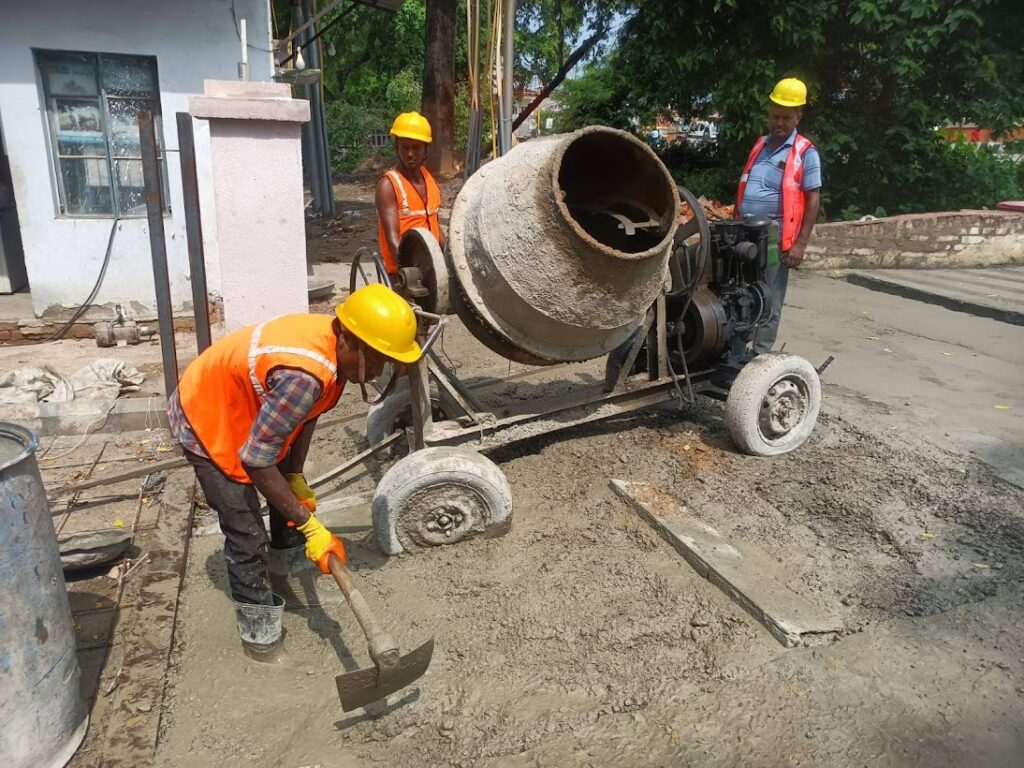Procedure of RCC road construction
The procedure for constructing an RCC (Reinforced Cement Concrete) road typically involves the following steps:

Survey and Design: The first step is to carry out a survey of the proposed road route and determine the alignment and elevation. Based on this, a detailed design is prepared, which includes the thickness of the pavement, the reinforcement details, and the type of concrete mix to be used.
Excavation and Subgrade Preparation: The area where the road is to be constructed is cleared of any vegetation, debris, and topsoil. The subgrade is then prepared by excavating the soil to the required depth and compacting it to achieve the necessary density.
Sub-base and Base Course: A layer of granular material is laid on top of the subgrade to form the sub-base. This is followed by the base course, which is a layer of crushed stone or gravel that provides a stable foundation for the pavement.
Formwork: Formwork is erected along the edges of the road to define the shape of the pavement and hold the concrete in place during pouring and curing.
Reinforcement: Steel reinforcement is placed in the formwork in a grid pattern to provide tensile strength to the pavement and prevent cracks from forming.
Concrete Pouring: The concrete is mixed in a batching plant and transported to the site in trucks. The concrete is poured into the formwork and leveled using a screed board. The surface is then finished with a trowel to achieve a smooth surface.
Curing: The concrete is left to cure for a few days to achieve its full strength. The surface may be covered with a curing compound or wet burlap to prevent the concrete from drying out too quickly.
Expansion and Contraction Joints: Expansion joints are placed at regular intervals along the length of the road to allow for expansion and contraction due to temperature changes. These joints are typically filled with a compressible material to prevent the formation of cracks.
Finishing: Once the concrete has cured, the formwork is removed, and the surface is cleaned and finished to achieve the desired texture and appearance.
Traffic Markings: Finally, traffic markings and signs are added to the road surface to guide and inform drivers.
RCC road construction process- Trimix flooring
Why RCC road construction is preferred over other types of Road construction?
RCC (Reinforced Cement Concrete) roads are preferred over other types of roads due to their high durability, strength, and low maintenance requirements. The following are some of the reasons why RCC roads are used in construction:
High Strength: RCC roads have high compressive strength and can withstand heavy traffic loads without significant deformation.
Durability: RCC roads are highly durable and have a longer lifespan compared to other types of roads.
Low Maintenance: RCC roads require very little maintenance, which makes them a cost-effective option in the long run.
Resistant to Weathering: RCC roads are resistant to weathering, including rain, snow, and extreme temperatures.
Resistant to Cracking: The use of steel reinforcement in RCC roads makes them resistant to cracking, which can be a problem in other types of roads.
Environmentally Friendly: The use of locally available materials and the low maintenance requirements of RCC roads make them an environmentally friendly option.
Faster Construction: RCC roads can be constructed faster compared to other types of roads, which is an advantage in areas where traffic disruption needs to be minimized.
Overall, RCC roads provide a durable and long-lasting solution for transportation infrastructure, making them a preferred option in many construction projects.
Leave a Reply